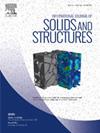预测纳米尺度应力-应变曲线:贝叶斯框架内的高斯过程
IF 3.8
3区 工程技术
Q1 MECHANICS
International Journal of Solids and Structures
Pub Date : 2025-05-06
DOI:10.1016/j.ijsolstr.2025.113438
引用次数: 0
摘要
本研究介绍了一种创新的方法,用于概率预测纳米材料的应力应变曲线,并特别关注材料体积。为了实现这一目标,分子动力学(MD)模拟在不同材料尺寸上进行,以收集应力-应变数据。随后,采用了一种复杂的方法,将高斯过程(GP)集成到贝叶斯框架中,对不同尺寸材料的应力-应变行为进行了综合建模,并预测了完整的应力-应变曲线。这种概率机器学习算法的独特之处在于,它不仅能够提供对材料行为的精确预测,还能提供对不确定性的详细评估。这一特性确保了其在生成准确的应力-应变特性预测方面的有效性,超越了MD模拟中遇到的材料体积所带来的传统限制。在这样做的过程中,它解决了原子模拟固有的尺寸限制的关键挑战。为了严格验证该方法的能力,我们使用纯铜作为实验材料进行了广泛的测试,并受益于其全面的应力-应变数据库。重要的是要注意,这种方法并不局限于任何特定的材料;相反,它是一种可靠而通用的工具,用于概率预测纳米材料的机械性能。因此,这种方法在材料科学和工程领域的各种应用中具有巨大的潜力,为研究人员提供了一种宝贵的手段来深入了解纳米尺度上材料的行为。本文章由计算机程序翻译,如有差异,请以英文原文为准。
Predicting nanoscale stress-strain curves: A Gaussian processes within a Bayesian framework
This study introduces an innovative method for probabilistically predicting the stress–strain curves of nanoscale materials, with a specific focus on material volume. To achieve this, molecular dynamics (MD) simulations were meticulously conducted across various material sizes to gather stress–strain data. Subsequently, a sophisticated approach was employed, integrating a Gaussian process (GP) within a Bayesian framework to comprehensively model the stress–strain behavior and forecast the complete stress–strain profiles for materials of different sizes. What sets this probabilistic machine learning algorithm apart is its capacity to not only offer precise predictions of material behavior but also to provide a detailed assessment of uncertainty. This feature ensures its effectiveness in generating accurate forecasts of stress–strain characteristics, surpassing the conventional limitations posed by material volume encountered in MD simulations. In doing so, it addresses the crucial challenge of size restrictions inherent to atomistic simulations. To rigorously validate the capabilities of this methodology, we conducted extensive testing using pure copper as our experimental material, benefitting from its comprehensive repository of stress–strain data. It is important to note that this methodology is not restricted to any specific material; instead, it serves as a robust and versatile tool for probabilistically predicting the mechanical properties of nanoscale materials. Consequently, this approach holds immense potential for diverse applications within the field of materials science and engineering, offering researchers an invaluable means to gain insights into the behavior of materials at the nanoscale.
求助全文
通过发布文献求助,成功后即可免费获取论文全文。
去求助
来源期刊
CiteScore
6.70
自引率
8.30%
发文量
405
审稿时长
70 days
期刊介绍:
The International Journal of Solids and Structures has as its objective the publication and dissemination of original research in Mechanics of Solids and Structures as a field of Applied Science and Engineering. It fosters thus the exchange of ideas among workers in different parts of the world and also among workers who emphasize different aspects of the foundations and applications of the field.
Standing as it does at the cross-roads of Materials Science, Life Sciences, Mathematics, Physics and Engineering Design, the Mechanics of Solids and Structures is experiencing considerable growth as a result of recent technological advances. The Journal, by providing an international medium of communication, is encouraging this growth and is encompassing all aspects of the field from the more classical problems of structural analysis to mechanics of solids continually interacting with other media and including fracture, flow, wave propagation, heat transfer, thermal effects in solids, optimum design methods, model analysis, structural topology and numerical techniques. Interest extends to both inorganic and organic solids and structures.

 求助内容:
求助内容: 应助结果提醒方式:
应助结果提醒方式:


